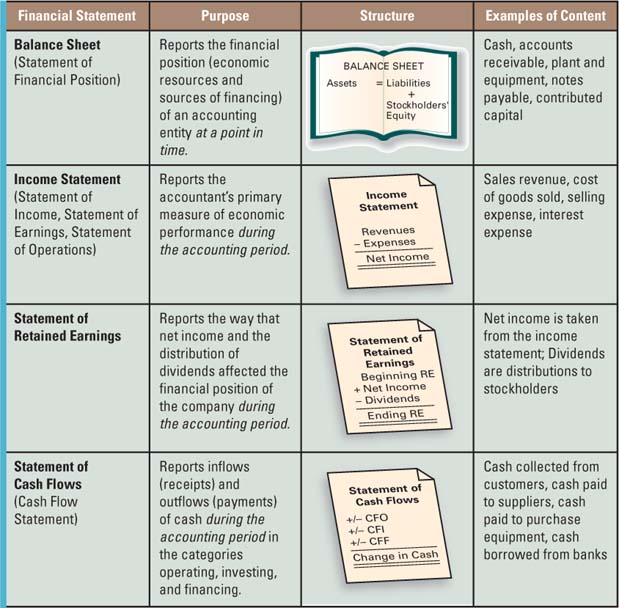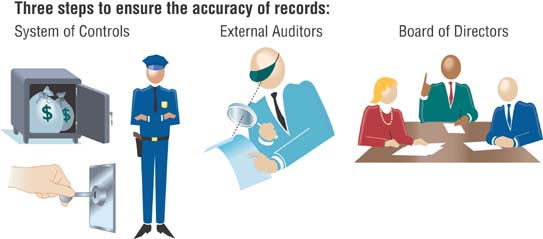
(See related pages)
Decision makers also need to understand the measurement rules applied in computing the numbers on the statements. A swim coach would never try to evaluate a swimmer's time in the 100 freestyle without first asking if the time was for a race in meters or in yards. Likewise, a decision maker should never attempt to use accounting information without first understanding the measurement rules that were used to develop the information. These measurement rules are called generally accepted accounting principles,(GAAP) are the measurement rules used to develop the information in financial statements. or GAAP(GAAP) are the measurement rules used to develop the information in financial statements..
Generally Accepted Accounting PrinciplesHow Are Generally Accepted Accounting Principles Determined? The accounting system in use today has a long history. Its foundations are normally traced back to the works of an Italian monk and mathematician, Fr. Luca Pacioli, published in 1494. However, prior to 1933, each company's management largely determined its financial reporting practices. Thus, little uniformity in practice existed among companies. Following the dramatic stock market decline of 1929, the Securities Act of 1933 and the Securities Exchange Act of 1934 were passed into law by the U.S. Congress. These acts created the Securities and Exchange Commission(SEC) is the U.S. government agency that determines the financial statements that public companies must provide to stockholders and the measurement rules that they must use in producing those statements. (SEC) and gave it broad powers to determine the measurement rules for financial statements that companies issuing stock to the public (publicly traded companies) must provide to stockholders.7 The SEC has worked with organizations of professional accountants to establish groups that are given the primary responsibilities to work out the detailed rules that become generally accepted accounting principles. Today, the Financial Accounting Standards Board(FASB) is the private sector body given the primary responsibility to work out the detailed rules that become generally accepted accounting principles. (FASB) has this responsibility. The Board has five full-time voting members and a permanent staff who consider the appropriate financial reporting responses to ever-changing business practices. As of the date of publication of this book, the official pronouncements of the FASB (Financial Accounting Standards) and its predecessors totaled more than 5,000 pages of very fine print. Such detail is made necessary by the enormous diversity and complexity of current business practices. Most managers do not need to learn all the details included in these standards. Our approach is to focus on those details that have the greatest impact on the numbers presented in financial statements and are appropriate for an introductory course. Why Is GAAP Important to Managers and External Users? Generally accepted accounting principles (GAAP) are of great interest to the companies that must prepare financial statements, their auditors, and the readers of the statements. Companies and their managers and owners are most directly affected by the information presented in financial statements. Companies incur the cost of preparing the statements and bear the major economic consequences of their publication, which include, among others,
Recall that the amount that Exeter was willing to pay to purchase Maxidrive was determined in part by net income computed under GAAP. This presents the possibility that changes in GAAP can affect the price buyers are willing to pay for companies. Employees who receive part of their pay based on reaching stated targets for net income are directly concerned with any changes in how net income is computed under GAAP. Managers and owners also often are concerned that publishing certain information in financial statements will give away trade secrets to other companies that compete with them. As a consequence of these and other concerns, changes in GAAP are actively debated, political lobbying often takes place, and final rules are a compromise among the wishes of interested parties.
Management Responsibility and the Demand for Auditing
Exeter's owners and managers were well aware of the details of U.S. GAAP, but they were still misled. Although the measurement rules that Maxidrive had used to produce its financial statements were consistent with GAAP, the underlying figures were fictitious. Who was responsible for the accuracy of the numbers in Maxidrive's financial statements? Primary responsibility for the information in the financial statements lies with management, represented by the highest officer of the company and the highest financial officer. Companies take three important steps to assure investors that the company's records are accurate: (1) they maintain a system of controls over both the records and the assets of the company, (2) they hire outside independent auditors to verify the fairness of the financial statements, and (3) they form a committee of the board of directors to oversee the integrity of these other two safeguards. These responsibilities are often reiterated in a formal report of management or management certification in the annual report. These three safeguards and a management certification are required for companies with publicly traded stock. These safeguards failed in Maxidrive's case. Managers of companies that prepare fraudulent financial statements are subject to criminal and civil penalties.
The role of the independent auditor is described in more detail in the audit report in Exhibit 1.8 (report of independent accountants or independent registered public accounting firm). The audit report describes the auditor's opinion of the fairness of the financial statements and the evidence gathered to support that opinion. An accountant may be licensed as a certified public accountant, or CPA, only on completion of requirements specified by each state. Only a licensed CPA can issue an audit report. In this role, accountants are known as independent CPAs (or independent accountants) because they have certain responsibilities that extend to the general public as well as to the specific business that pays for this service. An auditAn AUDIT is an examination of the financial reports to ensure that they represent what they claim and conform with GAAP. involves the examination of the financial reports (prepared by the management of the entity) to ensure that they represent what they claim to and conform with generally accepted accounting principles (GAAP). In performing an audit, the independent CPA examines the underlying transactions and the accounting methods used to account for these transactions. Because of the enormous number of transactions involving a major enterprise such as Apple, the CPA does not examine each of these transactions. Rather, professional approaches are used to ascertain beyond reasonable doubt that transactions were measured and reported properly. The Public Company Accounting Oversight BoardThe PUBLIC COMPANY ACCOUNTING OVERSIGHT BOARD(PCAOB) is the private sector body given the primary responsibility to issue detailed auditing standards. (PCAOB), in consultation with the SEC, sets standards for these tests for the audits of public companies.
Ethics, Reputation, and Legal Liability
If financial statements are to be of any value to decision makers, users must have confidence in the fairness of the information they present. Users will have greater confidence in the information if they know that the people who audited the statements were required to meet professional standards of ethics and competence. The American Institute of Certified Public Accountants (AICPA) requires all of its members to adhere to a professional code of ethics and professional auditing standards, and auditors of public companies must register with and comply with standards set by the PCAOB. Failure to comply with the rules of conduct can result in serious professional penalties. CPAs' reputations for honesty and competence are their most important assets. The potential economic effects of damage to reputation, malpractice liability, and potential fines provide even stronger incentives to abide by professional standards. In case of malpractice, the independent CPA may be held liable for losses suffered by those who relied on the statements the CPA examined. As a result of the fraud, Maxidrive filed for bankruptcy and will likely be sold in an attempt to pay off creditors. In a civil lawsuit, Exeter Investors and American Bank claimed losses of $16.5 million and $9 million, respectively, charging that the officers of Maxidrive had “perpetrated a massive fraud” and the auditors had “overlooked the errors” in the audit. Exeter and American Bank also have asked for punitive damages for gross negligence. In addition, the president and the chief financial officer of Maxidrive were convicted by a federal jury on three counts of criminal securities fraud for which they were fined and imprisoned. 7Contrary to popular belief, these rules are different from those that companies follow when filing their income tax returns. We discuss these differences further in later chapters. | |||||||||||||||||||||||||||||





